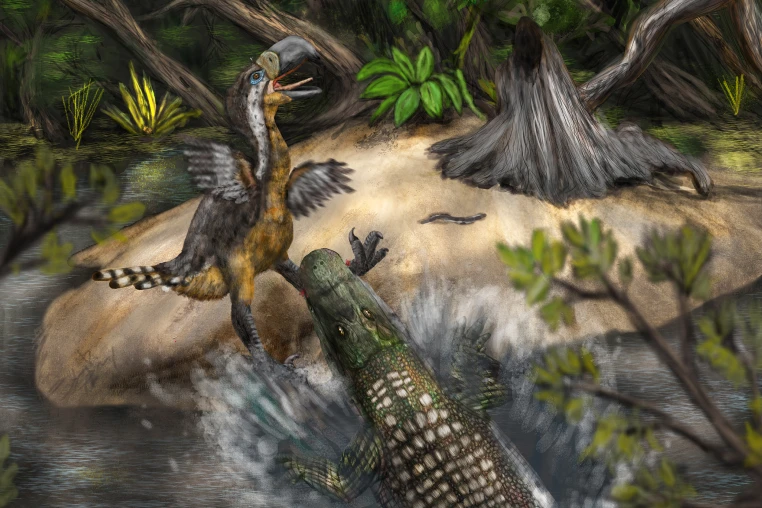Giant 'Terror Bird' May Have Fallen Prey to Massive Caiman 13 Million Years Ago
By Edwin V. Christopher

New research published in Biology Letters sheds light on a rare and dramatic predator‑prey interaction from Colombia’s Miocene epoch, suggesting that a massive caiman may have either hunted or scavenged a giant 'terror bird'—one of South America’s most formidable prehistoric land predators The discovery centers on a fossilized leg bone belonging to a phorusrhacid, commonly known as a terror bird, that dates back roughly 12 to 13 million years and was unearthed at the La Venta site in Colombia’s Tatacoa Desert The bone contains four distinct tooth marks consistent with bites from a large crocodilian, most likely a juvenile Purussaurus neivensis, a giant caiman species that could reach lengths up to 10 meters in adulthood and roamed the same region at the same time The terror birds—members of the family Phorusrhacidae—were apex terrestrial predators endemic to South America during the Cenozoic, some species towering over 2.7 meters (9 feet) tall and weighing as much as 350 kg Their anatomy featured powerful legs, rigid hooked beaks, and adept running ability designed to subdue smaller prey—though large prey required precise strikes rather than brute force Professor Andrés Link of the University of the Andes led the analysis, noting that terror birds dominated the ecosystem, but the new evidence reveals that approaching water sources made them vulnerable to aquatic predators like Purussaurus “Terror birds were undoubtedly at the top of the food chain,” he said. “But this evidence shows us that they could also fall as prey of large caimans when approaching large water bodies” To investigate the marks, researchers performed 3D surface scans of the bone and digitally compared bite impressions to reconstructed skull models of extant caiman species and fossil records of Purussaurus neivensis The tooth spacing, curvature, and alignment closely matched that of a juvenile caiman approximately 4.6 to 4.8 meters long. No healing was visible around the marks, indicating the bird died soon after—or perhaps had already died before the bites occurred The marks are rounded, linear, and show no signs of gnawing or wear expected from mammals, reinforcing that crocodilian jaws, not mammalian teeth, produced them Prof. Link ruled out mammalian predators based on mark morphology and absence of gnawing, concluding that the encounter was with a crocodyliform at or near a water edge The fossil was first excavated more than 15 years ago in the Tatacoa Desert—a region rich in vertebrate fossils. Until now, evidence of direct interaction between apex creatures like terror birds and caimans has been limited. The recent study provides rare insight into ecological dynamics of the middle Miocene, and suggests that even dominant predators faced substantial aquatic threats The researchers acknowledge uncertainty about whether the caiman actively preyed on the bird or scavenged a carcass. While a powerful bite could kill such a bird, it's plausible the creature died from other causes and the caiman opportunistically scavenged the remains. Nonetheless, the absence of healing confirms the marks occurred at or near the time of death In addition to shedding light on Purussaurus’s diet and bite force, the finding implies dense interactions between aquatic and terrestrial predators in proto‑Amazonian ecosystems, especially in dry seasons when land predators would approach water sources for prey or hydration Dr. Carolina Acosta Hospitaleche from Argentina’s National University of La Plata noted that tooth marks similar to these may be more common than believed. She previously identified similar evidence on a much older (43‑million‑year‑old) terror bird fossil in Argentina, suggesting predator interactions were frequent enough to leave traceable marks, though fossil preservation biases limit detection The study highlights broader evolutionary implications: terror birds were apex predators, yet their dominance did not render them invulnerable. Particularly near water, giant caimans like Purussaurus posed a lethal risk—delivering a more nuanced understanding of past food webs and ecological boundaries The terror bird species involved is estimated to have stood over 2.7 meters tall. The caiman in question—an adolescent Purussaurus—would become one of the largest crocodyliforms ever known, rivaling some dinosaurs in size. Adult Purussaurus could weigh multiple tons and dominate riverbanks in Miocene Colombia Scientific observers point out that such interactions illuminate a landscape of fear: water sources were contested zones where even the most fearsome land predators could meet their ends beneath aquatic kings In analogies to modern African waterholes, large predators occasionally fall victim to crocodiles; this fossil record confirms similar dynamics existed in ancient South America While this instance is singular, it emphasizes how fossil traces—bite marks—can reveal behavior that bones alone cannot tell Researchers stress the importance of continued analysis of trace fossils to reconstruct predator hierarchies and interspecies competition in prehistoric ecosystems In summary, the discovery of shark‑like bite marks on a terror bird shin bone overturns assumptions about ancient apex predators’ invulnerability. It forces a reassessment of predator chains in Miocene South America, illustrating that size and dominance on land provided no guarantee of survival near water. This rare snapshot into prehistoric life helps scientists better understand the environmental pressures and predator behaviors that shaped evolution during the Miocene epoch, roughly 12 to 13 million years ago.